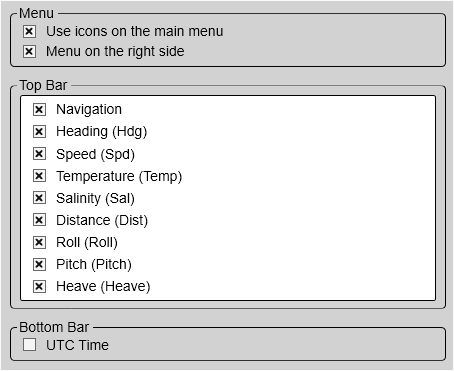General page
The General page in the Display Options dialog box controls the location of the menu. You can select which navigational information to be shown on the top bar. You can also choose to see Coordinated Universal Time (UTC) at the bottom of the presentation.
How to open
This page is located in the Display Options dialog box. The Display Options dialog box is located on the Display menu.


Description
The General page offers a range of "on/off switches". You use them to enable or disable the relevant functions.
Note
The information shown on the top bar must not be used for vessel navigation.
Details
Menu on the Right Side
Top Bar
The top bar is located at the top of the display presentation and stretches from the far left to the far right. By means of these check boxes, you can select which elements to be shown at the top of the presentation.
For each option, the text in brackets is the identification used on the top bar. The text used to identify the depth option reflects the information you added as Custom Name when you installed the transducer on the Transducer Installation page in the Installation dialog box.
Navigation
Heading
Speed
Temperature
Salinity
Distance
Roll
Pitch
Heave
Depth
Select this check box to see the current water depth on the top bar. The information is taken from the chosen transducer. The text used to identify the depth option reflects the information you added as Custom Name when you installed the transducer on the Transducer Installation page in the Installation dialog box.
Bottom Bar
Check the box to use Coordinated Universal Time (UTC). The time is shown on the bottom bar at the bottom of the display presentation. When disabled, the EK80 system uses local time.
Note
To enable UTC time, your EK80 system must be set up to accept the NMEA ZDA datagram. The NMEA ZDA datagram contains the universal time code (UTC), day, month, year and local time zone.
Coordinated Universal Time (French: Temps Universel Coordonné, UTC) is the primary time standard by which the world regulates
clocks and time. It is one of several closely related successors to Greenwich Mean Time (GMT). For most purposes, UTC is used
interchangeably with GMT, but GMT is no longer precisely defined by the scientific community. [...]
The current version of UTC is defined by International Telecommunications Union Recommendation (ITU-R TF.460-6), Standard-frequency
and time-signal emissions and is based on International Atomic Time (TAI) with leap seconds added at irregular intervals to
compensate for the slowing of Earth's rotation. Leap seconds keep UTC within 0.9 seconds of universal time, UT1.
Wikipedia, Copied June 2014